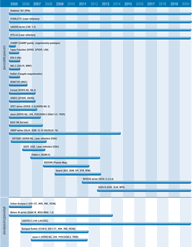Gravity, magnetic, and geodynamic measurements
Not all near-Earth measurements undertaken by satellite observations are discussed in this document, since the focus here is on land, sea, and air parameters; but many more are observed on a routine basis, including measurements of the space environment and solar activity, amongst others. Of particular note are measurements of the Earth’s gravity field, magnetic field, and geodynamic activity.
Gravity field measurements from space provide the most promising advances for improved measurement of the ‘geoid’ and its time variations. The geoid is the surface of equal gravitational potential at mean sea level, and reflects the irregularities in the Earth's gravity field at the Earth's surface due to the inhomogeneous mass and density distribution in the Earth's interior. Such measurements are vital for quantitative determination, in combination with satellite altimetry, of absolute ocean currents, improving global height references, estimates of the thickness of the polar ice sheets and its variations and estimates of the mass/volume redistribution of freshwater in order to further understand the hydrological cycle.
Gravity field measurement packages on satellites often utilise combinations of different instrument types in order to derive the necessary information: single or multiple accelerometers; precise satellite orbit determination systems; and satellite to satellite tracking systems.
DLR’s CHAMP gravity package has been providing new information on the Earth’s gravity field since 2000. Two new missions, one launched by NASA in 2002 (the twin satellite GRACE) and one planned by ESA (GOCE, in 2006), will provide new and unique models of the Earth’s gravity field and its variability over time, allowing determination of the geoid to 1cm accuracy.
A number of Earth missions, including Australia's Fedsat launched in 2002, have carried sensors to study the electromagnetic environment of spacecraft. Satellite-borne magnetometers provide information on strength and direction of the internal and external Earth’s magnetic field and its time variations The CHAMP mission makes such measurements - which are of value in a range of applications, including navigation systems, resource exploration drilling, spacecraft attitude control systems, and assessments of the impact of ‘space weather’.
Further missions are underway or planned for more in-depth, dedicated studies of magnetic field - including: DEMETER (launched June 2004) which is investigating links between earthquakes and magnetic field variations; and SWARM (from 2009) which aims to provide the best ever survey of the geomagnetic field and its temporal evolution, and gain new insights into improving our knowledge of the Earth’s interior and climate.

